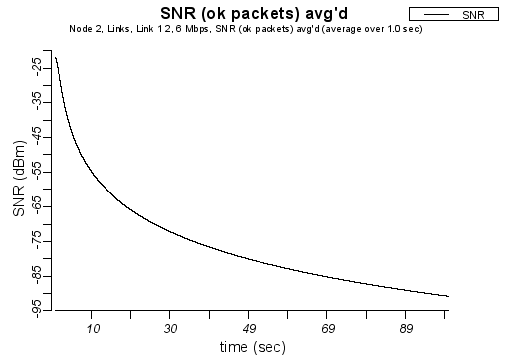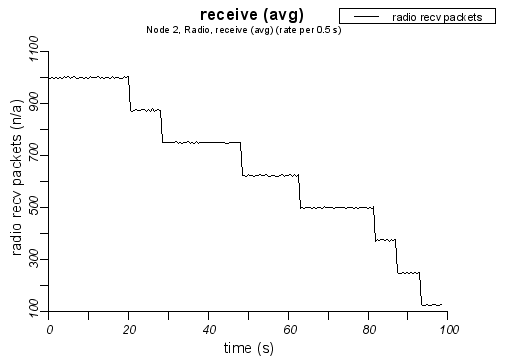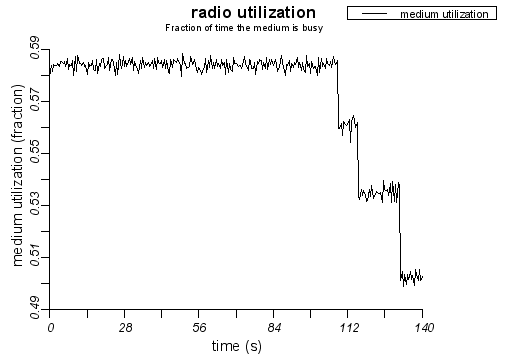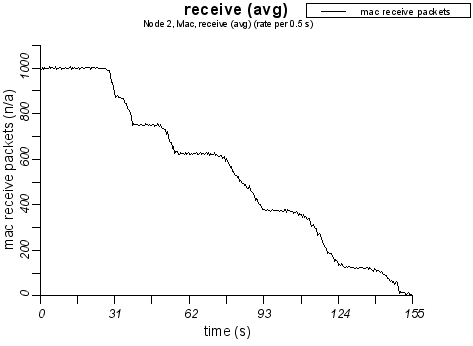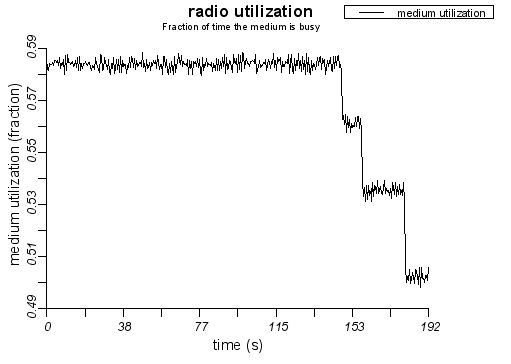Brn.Phy: Difference between revisions
| Line 1: | Line 1: | ||
Details about the physical layers in Brn.Sim. Tbd. |
Details about the physical layers in Brn.Sim. Tbd. |
||
= |
= Propagation = |
||
== |
== Large Scale Path Loss == |
||
Currently Brn.Sim supports the path loss models FreeSpace, TwoRay and LogDistance. |
|||
=== Free Space Path Loss === |
|||
=== Two Ray Path Loss === |
|||
=== Log-Distance based Path Loss === |
|||
[[Image:dist-snr-simplepathloss-3.5.png]] |
[[Image:dist-snr-simplepathloss-3.5.png]] |
||
Pathloss using the log-distance based model (see Goldsmith Wireless Communication p. 40) and path loss exponent 3.5 (1sec == 1m). |
Pathloss using the log-distance based model (see Goldsmith Wireless Communication p. 40) and path loss exponent 3.5 (1sec == 1m). |
||
== |
== Shadow Fading == |
||
== Small Scale Fading == |
|||
== |
== Implementation Details == |
||
== Hierarchical Binning == |
=== Hierarchical Binning === |
||
JiST/SWANS use spatial binning to improve simulation performance, similar to SNS ([http://www.cs.cornell.edu/people/egs/sns/ STAGED NETWORK SIMULATOR]). The idea is to partition the simulation area into bins. If a node at position X emits a signal, that a bin is visited only if the signal strength at a defined reference location (the location inside the bin nearest to X) exceeds a certain threshold. Thus, spatial binning prunes all bins in which none of the nodes would receive the signal. |
JiST/SWANS use spatial binning to improve simulation performance, similar to SNS ([http://www.cs.cornell.edu/people/egs/sns/ STAGED NETWORK SIMULATOR]). The idea is to partition the simulation area into bins. If a node at position X emits a signal, that a bin is visited only if the signal strength at a defined reference location (the location inside the bin nearest to X) exceeds a certain threshold. Thus, spatial binning prunes all bins in which none of the nodes would receive the signal. |
||
Revision as of 12:51, 16 March 2008
Details about the physical layers in Brn.Sim. Tbd.
Propagation
Large Scale Path Loss
Currently Brn.Sim supports the path loss models FreeSpace, TwoRay and LogDistance.
Free Space Path Loss
Two Ray Path Loss
Log-Distance based Path Loss
Pathloss using the log-distance based model (see Goldsmith Wireless Communication p. 40) and path loss exponent 3.5 (1sec == 1m).
Shadow Fading
Small Scale Fading
Implementation Details
Hierarchical Binning
JiST/SWANS use spatial binning to improve simulation performance, similar to SNS (STAGED NETWORK SIMULATOR). The idea is to partition the simulation area into bins. If a node at position X emits a signal, that a bin is visited only if the signal strength at a defined reference location (the location inside the bin nearest to X) exceeds a certain threshold. Thus, spatial binning prunes all bins in which none of the nodes would receive the signal.
However, there is a problem with shadowing and fading, because signal strength and distance are not monotonically any more. So there is a probability that the binning prunes bins because of severe fading at the reference location, whereas other nodes within the bin would receive the signal. We address this problem by adding a fading margin to the reference signal strength calculation. In detail, we use the 95. percentile for log-normal fading and the 99. percentile for Rician fading.
Receiver Models
SNR based Receiver
The SNR model defines two thresholds: a sensing and a receiving threashold. If the SNR of the incoming packet is above the receiving (sensing) threshold, the packet is received (sensed). The thresholds are generally different for different bit rates and they are also hardware dependent.
In this example a node transmits 2000 frames per second, using all available IEEE 802.11g bit rates. A second node is placed near the sender and moves away with 1 m/s. We are again using the log-distance pathloss model with exponent 3.5. While the receiver moves away the SNR of received packets also decrease. Eventually it drops below the threshold for the used bit rate and the frame is not received. Instead the receiver only senses the frame. While moving further away the received SNR eventually drops below the sensing threshold (see next figure). Note that there is only one sensing threshold per receiver, but our IEEE 802.11g transmitter uses different power levels for different bit rates.
BER based Receiver
The BER receiver model calculates Bit and Packet Error Rates, which are used as probability whether a frame is received without error. Frame reception becomes a stochastic process depending on the used modulation and coding scheme (i.e. bit rate), the SNR (distance) and number of bits.
Both figures show the number of received and sensed frames for the BER receiver in the same scenario described in the previous section. Note that the thresholds of the SNR receiver caused sharp fall-offs: At a certain point the PER for a given bit rate changed abruptly from 0 to 1. Using the BER receiver we now have soft transition. Note further that the sensing range is larger compared to the SNR receiver, because the model still uses thresholds for preamble detection. This may not be very realistic and will likely be changed in future versions.
References
- Goldsmith Wireless Communication
- Paper yans physical layer
